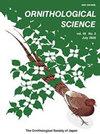Effects of Rearing Methods on the Reproduction of Reintroduced Crested Ibis Nipponia nippon on Sado Island, Japan
IF 0.3
4区 生物学
Q4 ORNITHOLOGY
引用次数: 0
Abstract
Abstract An increasing number of reintroduction programs have been set up in recent years in an attempt to reintroduce once extinct species to their indigenous ranges and create self-sustaining populations. However, the released individuals often experience low mating success and fecundity. Appropriate rearing in captivity is considered essential for the successful post-release reproduction of captive-reared individuals. Low post-release mating success and fecundity are also issues in reintroduced Crested Ibis Nipponia nippon populations on Sado Island. These phenomena may be caused by the effects of hand-rearing in captivity, yet temporary hand-rearing is necessary when captive breeding, because rescuing embryos from mortality is essential due to the abnormal behavior of parent birds in captivity. Therefore, the establishment of rearing methods that temporarily protect embryos or chicks while limiting the negative effects of hand-rearing on breeding after release is needed. To overcome these challenges, we tested how captive rearing methods impact post-release courtship behavior, mating success, and fecundity of the ibis. By combining detailed rearing history in captivity with long-term post-release monitoring, we demonstrate that the initiation of parental rearing before the chicks' eyes open is the critical factor leading to increased pseudocopulation frequency and mating success in captive-born male ibis. Based on these results, not hand-rearing the chicks beyond the day after hatching would reduce the impact of hand-rearing on reproduction after release. Rearing methods that take into account the nestling period should be implemented to enhance the efficiency and reduce the cost of avian reintroduction projects.饲养方法对日本佐渡岛再引进朱鹮繁殖的影响
摘要近年来,越来越多的重新引入计划已经建立,试图将曾经灭绝的物种重新引入其本土范围,并创造自我维持的种群。然而,被释放的个体通常交配成功率和繁殖力较低。圈养条件下的适当饲养被认为是成功繁殖圈养个体的关键。在佐渡岛重新引入的朱鹮种群中,放生后交配成功率和繁殖力低也是一个问题。这些现象可能是由人工饲养的影响引起的,但在人工饲养时,临时人工饲养是必要的,因为由于圈养中亲本鸟类的异常行为,拯救胚胎免于死亡是至关重要的。因此,需要建立临时保护胚胎或雏鸡的饲养方法,同时限制人工饲养对放生后繁殖的负面影响。为了克服这些挑战,我们测试了圈养饲养方法如何影响朱鹭放生后的求偶行为、交配成功率和繁殖力。通过将详细的圈养饲养史与长期的放生后监测相结合,我们证明,在雏鸡睁开眼睛之前开始父母饲养是导致圈养出生的雄性朱鹭伪种群频率增加和交配成功的关键因素。基于这些结果,孵化后第二天之后不人工饲养小鸡将减少人工饲养对放生后繁殖的影响。应实施考虑到筑巢期的饲养方法,以提高鸟类重新引入项目的效率并降低成本。
本文章由计算机程序翻译,如有差异,请以英文原文为准。
求助全文
约1分钟内获得全文
求助全文
来源期刊

Ornithological Science
ORNITHOLOGY-
CiteScore
1.20
自引率
0.00%
发文量
26
审稿时长
>12 weeks
期刊介绍:
Ornithological Science publishes reviews, original articles, short communications and comments covering all aspects of ornithology. Manuscripts are judged on the basis of their contribution of original data and ideas or interpretation. All articles are peer-reviewed by at least two researchers expert in the field of the submitted paper. Manuscript are edited where necessary for clarify and economy. Ornithological Science aims to publish as rapidly as is consistent with the requirements of peer-review and normal publishing constraints.
 求助内容:
求助内容: 应助结果提醒方式:
应助结果提醒方式:


